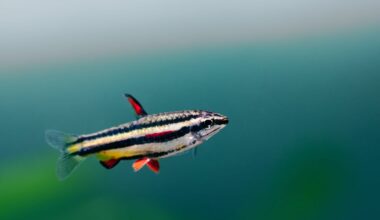There are a surprising amount of options out there when it comes to the best fish for 5 gallon tanks. Even though aquariums of this size are too small for many species, there are still plenty that can thrive!
This list will show you the best options available, and provide some helpful information about each. If you want to learn more about a particular species on our list simply click the link to read their in-depth care guide.
Author Note: While many of these fish can be kept in a 5 gallon tank, we typically advocate for a larger tank if possible. The extra size won’t take up much more room in your home, and will make a big difference on the overall health and happiness of your fish.
We created this list of the best fish for 5 gallon tanks primarily for aquarists who have tank size or budget constraints. But if you can, give your fish a little more room!
Betta Fish
Betta fish are the quintessential “Small Space” species. These fancy fish do not require massive aquariums to stay healthy. In fact, they’re used to shallow and cramped environments (which makes them one of the best fish for 5 gallon tanks).

Bettas are native to rice paddies in Southeast Asia. Their natural habitat is murky, difficult to navigate, and a little cramped.
On top of that, betta fish aren’t very social. They’re naturally aggressive and will usually pick fights with fish that encroach their domain. As a result, most aquarists choose to keep these fish on their own.
As long as you have the essentials, bettas will do just fine. Despite their lax space requirements, this species is a real stunner. Their eye-popping jewel-tone colors and expansive fins pack a huge visual punch.
- Size: 3 inches
- Difficulty: Beginner
Guppy Fish
Guppies are one of the most well-known species in the aquarium community. Great for seasoned aquarists and novices alike; they aren’t very demanding. Guppies can get by with very little space, thanks in large part to their tiny size.

These fish for 5 gallons tanks only get to be a hair over two inches at the largest. But don’t let that fool you into thinking that guppies are dull or boring. Male guppy fish sport a fan-like tail filled with beautiful colors and patterns.
Even in a compact aquarium, the fins are eye-catching. There are over 300 guppy varieties. Plus, they’re all peaceful and community-friendly fish. House a couple in a small tank, and you can enjoy their playful demeanor without a vast space commitment.
- Size: 2.4 inches (max)
- Difficulty: Beginner
Clown Killifish
Hailing from small streams in West Africa, the clown killifish is an interesting species. It doesn’t even reach an inch and a half in length. Plus, they’re used to shallow waters.

Despite their small stature, clown killifish are natural-born micro predators. They stick to the surface of the water to seek out insects and tiny microorganisms to eat. These fish pay no attention to plants, but they do appreciate the cover they provide.
If you look closely, you’ll notice that clown killifish are adorned with a lot of colors. The dart-shaped body features stripes of black, subtle yellow accents, and some splashes of bright blue.
- Size: 1.4 inches
- Difficulty: Beginner-Intermediate
Neon Tetra
No discussion about the best fish for 5 gallon tanks is complete without mentioning the neon tetra! These brightly colored critters are incredibly popular. They’re a schooling species that thrive in a community. As long as they have others around them, they are happy!

Neon tetras have a torpedo-shaped body. A long stripe of iridescent shimmering blue runs laterally along the body—meanwhile, a splash of red accents the tail.
Easy-going and docile, these types of tetras are a rather low-maintenance species. They’re also quite hardy and can perform well in a wide range of environments. That said, they do prefer conditions that mimic their natural habitat.
The warm, soft, and slightly acidic waters of South America are best.
- Size: 1.5 inches
- Difficulty: Beginner
Chili Rasbora
Next up, we have the chili rasbora. This species is considered a nano fish, as it only reaches about 0.7 inches in size. Needless to say, they are the perfect contenders for smaller aquariums.
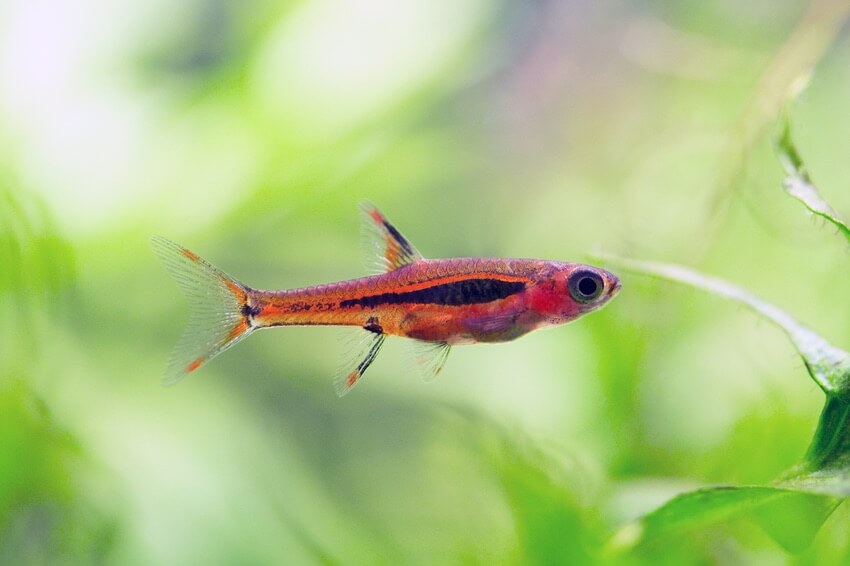
Of course, their small stature doesn’t mean that they don’t make a visual impact. Their intense red coloration most often defines these fish. Black accents throughout the fins and body create a nice contrast that pops in tanks of any size.
Chili rasboras come from blackwater environments. You don’t have to go so far as to stain the water pitch black, but these fish do enjoy fine-tuned parameters. Some tannin infusion is always welcome. Most importantly, don’t forget to monitor conditions to prevent any significant health problems.
- Size: 0.7 inches
- Difficulty: Beginner
Sparkling Gourami
Sparkling gourami are pretty easy to please when it comes to space requirements, as they only reach a mere half-inch in size. The small stature of this species lends credence to its common name. A popular shoaling species, large swathes of fish create a glimmering display that you won’t forget.

These fish have a lot of colors packed into their small body! Look closely, and you’ll see polka-dotted fins, stripes or red, and a bright blue eye.
You’ll have to be patient to see all that detail. Sparkling gourami are quite active, zipping around the confined space to get their exercise fish.
When planning a habitat for sparkling gourami, don’t forget about plants! While these are some of the best fish for 5 gallons tanks, you’ll need to plan for standing water and tons of live vegetation (which can be challenging in a tank of that size).
- Size: 1.5 inches
- Difficulty: Beginner
White Cloud Mountain Minnow
White Cloud Mountain minnows are aptly named from where they originate. The species was first discovered on White Cloud Mountain in China. Since then, they’ve become one of the most popular fish for 5 gallon tanks (or anyone who is seeking a smaller species).

Natural surface skimmers, White Cloud Mountain minnows occupy the upper part of the water column. They do best in clear waters with precisely managed conditions. Unlike most fish in the trade, this species isn’t tropical.
They prefer cooler conditions, making it a challenge to create a thriving community. White Cloud Mountain minnows can live in warm waters temporarily. But long-term living will decrease their lifespan.
Create a cool-water habitat filled with plants to see the best results.
- Size: 1.5 inches
- Difficulty: Beginner-Intermediate
Molly Fish
Molly fish, or mollies as they are affectionately called, are another community staple. Fish enthusiasts all over the world revere these simple livebearers.

Small and self-sufficient, mollies are a breeze to take care of. They’re undemanding and can breed prolifically with very little intervention on your part.
The best part of owning a molly fish is that it’s very adaptable. While they have their preferences, the parameter range is quite wide with this species. They can thrive in everything from barren freshwater environments to lush brackish waters!
Mollies are available in a wide range of colors as well. They can also take on a few different fin designs, giving you plenty of aesthetic options.
- Size: 4 to 4.5 inches
- Difficulty: Intermediate
Endler’s Livebearer
At one point in time, Endler’s livebearers were lumped into the same group as guppies. At face value, they look very similar! Both have a pint-sized torpedo body and an expansive fin. The two species are also livebearing.
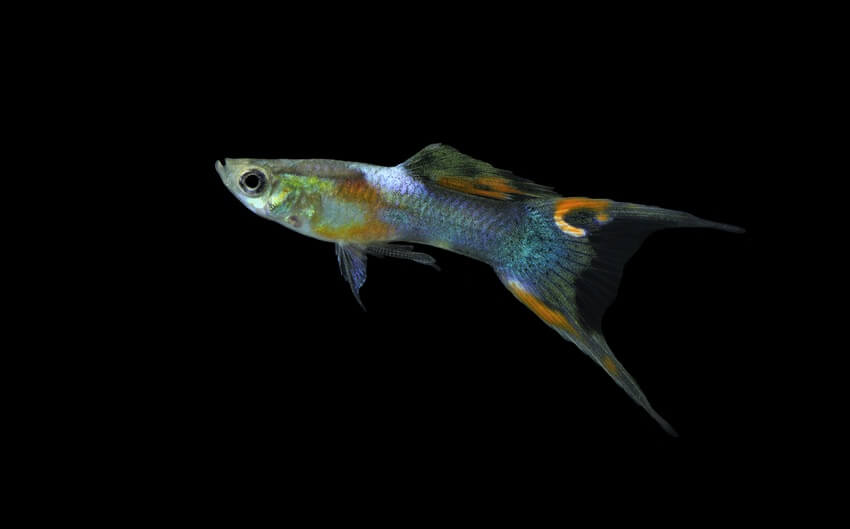
But, Endler’s livebearers are a unique species in their own right. Like guppies and mollies, Endler’s livebearers come in a myriad of colors. This species is quite vibrant, taking on several patches of neon hues. Many also have transparent patches, creating the illusion of floating color.
This species is endemic to a single body of water, Laguna De Patos. Thus, they do have specific parameter requirements to meet. To stay healthy, Endler’s livebearers need hard water and relatively high pH levels.
- Size: 1.8 inches
- Difficulty: Beginner
Honey Gourami
The honey gourami has a similar appearance to standard gourami. Their bodies are slim, leading to a point at the supra terminal mouth. They even have the thread-like pectoral fins that are iconic for the gourami species.

However, the honey gourami has a significantly different color. This particular species takes on an orange-red color, which is a drastic difference from the blue hues standard gouramis.
This species is also quite small, reaching about two inches long as adults. This makes them another great fish for a five gallon tank.
They’re peaceful and can be a bit timid around highly active fish. As a result, they do fine in closer quarters around others. These fish require clear access to the surface as well, as they are air-breathing labyrinth fish.
- Size: 2 inches
- Difficulty: Intermediate-Expert
Scarlet Badis
Another nano species, the scarlet badis has no issues living comfortably in a small aquarium. Adult males reach less than an inch long. Females only make it to about half an inch!
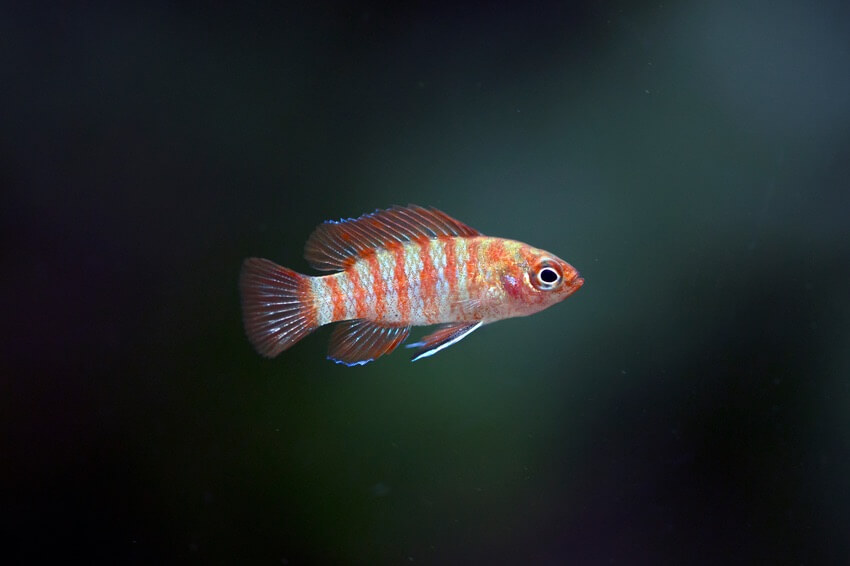
Even still, the beauty of the scarlet badis is undeniable. Clad in gold and orange, these fish stand out in nearly any environment. Small accents of blue make the fins pop and provide a touch of glimmer as they skitter around the tank.
Keeping scarlet badis in good shape can be a bit of a handful. They are on the picky side when it comes to parameters. Make sure to test the conditions regularly and perform routine water changes to avoid significant shifts in pH.
- Size: 0.8 inches
- Difficulty: Intermediate
Dwarf Pea Puffer
These adorable little creatures have become increasingly popular in recent years. It’s not hard to see why!

The dwarf pea puffer has a dense and stout body. The belly is bright yellow. However, the top features swirls of green, brown, black, and shimmering gold. Tiny fins and enormous, bulbous eyes make this puffer look like a cartoon character!
When most think of puffers, they imagine fist-sized fish. However, the dwarf pea is only about an inch and a half when fully grown (which is why they’re commonly kept in 5 gallon aquariums).
Don’t expect to see the dwarf pea puffer darting through an aquarium. While they are active and move around a lot, they aren’t the most powerful swimmers. You might see them swimming through vegetation as they hide.
- Size: 1.5 inches
- Difficulty: Intermediate
Pygmy Corydoras
Many aquarists are familiar with the standard-size corydoras. They’re a popular catfish species that many include in community tanks. But did you know that a dwarf variant exists?
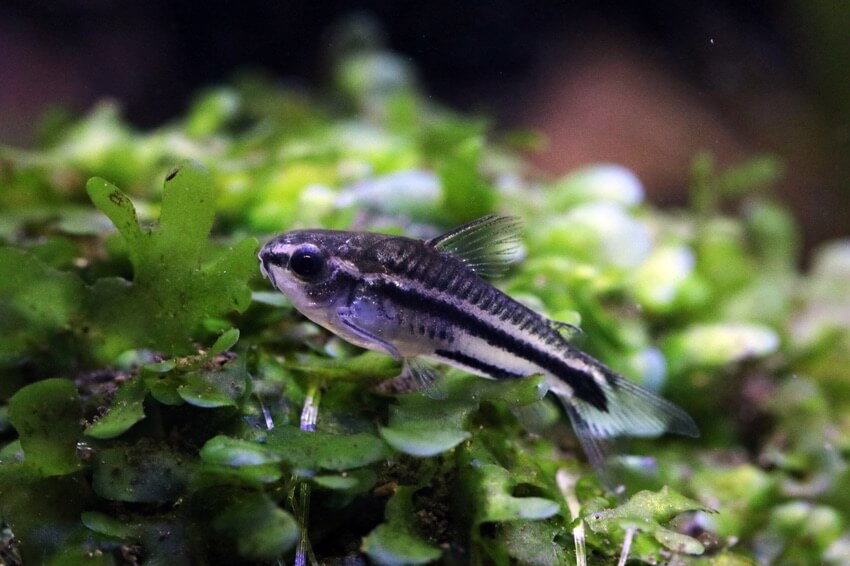
The dwarf corydoras, also known as the dwarf cory catfish, is a tiny version of the iconic species. It’s only about three-quarters of an inch long. However, it retains that signature cory shape.
You’ll see the under-turned mouth, the large eyes, and the bulbous body. Not only are they some of the best fish for 5 gallon tanks, they are also quite beautiful when it comes to their colorful design. Streaks of yellow intermingle with splashes of shimmer to create an eye-catching fish that gleams in the light.
- Size: 1 inch
- Difficulty: Beginner
Celestial Pearl Danio
Celestial pearl danios are a highly sought-after species with some awe-inspiring looks. The main body of the fish is deep blue. Cream-colored patches dot the body, mimicking the look of a starry night above!

The fins are bright red and feature distinct black striping. The unique combination of colors and patterns makes this fish one of the most beautiful around.
Caring for celestial pearl danios is pretty straightforward. But, you have to be careful about the conditions. They’re native to clean bodies of water filled with rich vegetation.
When parameters are off, celestial pearls are prone to stress and disease. They need right conditions, plenty of hiding spots, and a good diet to stay healthy.
- Size: 1 inch
- Difficulty: Intermediate
Least Killifish
At only about an inch long, least killifish are another species that does well in cramped quarters. They’re made to thrive in rougher conditions that other species can’t stomach.
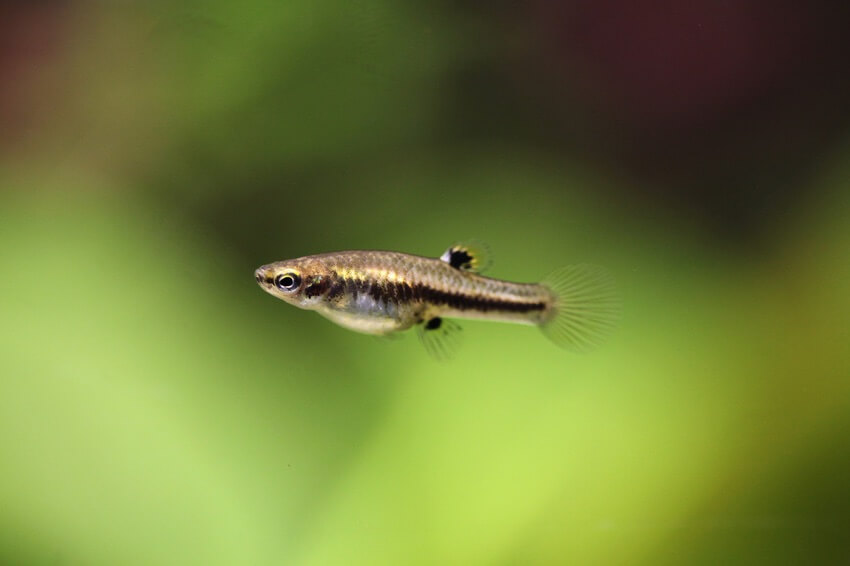
Least killifish come from stagnant bodies of water and sluggish waterways. You can often find them in coastal lowlands, searching through relatively barren environments to find food.
This species has adapted well to a rough life, making it a walk in the park in captivity. They’re not fussy when it comes to food and can do well in small habitats without missing a beat.
Sometimes shy and standoffish, least killifish do not like a lot of racket. They prefer to stay in their own lane and mind their business.
- Size: 1.4 inches
- Difficulty: Intermediate
Harlequin Rasbora
While not the brightest-colored fish in the world, harlequin rasboras still know how to attract attention. Their diamond-shaped body is accented with a triangular patch of black. It covers the lower half, creating a sharp contrast that draws the eye in an aquarium.

Harlequin rasboras are hardy community fish. They adapt well to most tropical conditions and can get along with just about any species. These fish prefer peace over aggression, but they can become targets to larger fish if you’re not careful.
This species also prefers blackwater environments. They enjoy the perks that come with tannin-filled water. The fish also like the privacy that comes with a dark cover.
- Size: 2 inches
- Difficulty: Beginner
Nerite Snail
If you want a critter that will actively keep your tank clean, the nerite snail is well worth your consideration. These tiny snails are lovely and discreet. They often spend their days clinging to surfaces in the tank as they chow down on algae.

Nerite snails are prolific algae eaters. They eat so much of the green stuff that you usually don’t have to feed them any supplementary food. A well-maintained aquarium will provide all the organic food they need.
This invert measures about an inch in diameter (which makes them a no-brainer for 5 gallon tanks). They come in many different colors and varieties. But, most feature muted yellow and black shells. You might see some high-contrast patterns like stripes and spots.
- Size: 1 inch
- Difficulty: Beginner
Cherry Shrimp
Here’s an ever-popular invertebrate in the freshwater aquarium community. Cherry shrimp are in high demand. So much so that breeders have a unique grading system to determine a shrimp’s value.

Specimens with more intense red coloration always fetch the highest price. Those shrimp feature the most solid and vibrant coloration. Lower grades may only have a couple of patches of red against a transparent body.
Cherry shrimp don’t need a ton of space to stay healthy. They do, however, require rich vegetation, surfaces to eat algae off of, and pristine water conditions. Like other invertebrates, cherry shrimp are prone to disease and stress when parameters go south.
- Size: 1.5 inches
- Difficulty: Beginner
Malaysian Trumpet Snail
Malaysian trumpet snails are another natural tank cleaner. These critters survive off of algae, plant detritus, and other forms of waste. They work hard to prevent leftover food and debris from souring tank conditions (which won’t be difficult in a five gallon tank).

The most exciting thing about this invert species is the shell. Rather than the sizable rounded shell of most freshwater snails, Malaysian trumpets have a conical one. Reaching lengths of up to one and a half inches, the cone is a powerful burrowing and navigation tool.
Malaysian trumpet snails have a lot to offer aquariums. But, they can also become a pest if you’re not careful. They breed rapidly, increasing your snail population in only a short period.
- Size: 0.5 inches
- Difficulty: Beginner
Amano Shrimp
Amano shrimp are fun aquatic creatures that are regularly kept in five gallon aquariums. They’re a joy to watch as they scurry around the tank and eat anything edible they can get their legs on.

This species is quite productive when it comes to algae-eating. A small group can prevent an aquarium from becoming cloudy or dangerous.
Best of all, individual shrimp don’t need a ton of room. Small groups can cohabitate just fine. Larger colonies will start to create bioload issues. But if you manage to keep numbers contained, they can thrive in smaller habitats.
All they need is some high-quality decor and plants. These freshwater aquarium shrimp will eat the plants as they decay and find surfaces to scrape algae.
- Size: 2 inches
- Difficulty: Beginner
Dwarf Crayfish
Here’s an interesting alternative to shrimp or snails. Dwarf crayfish are an excellent addition to smaller tanks. They look like miniature lobsters, complete with claws and everything!

However, they are much more manageable. Dwarf crayfish are only two inches or less in size. Plus, they are like tank janitors. They eat all the unfavorable stuff, leaving behind a healthy tank.
When setting up an aquarium for crayfish, it’s essential to provide plenty of decor. Plants, rocks, and driftwood act as hiding places for these creatures. They become quite vulnerable after molting, so amble hiding spots will make them feel more comfortable.
- Size: 1.6 to 2 inches
- Difficulty: Beginner
Conclusion
The best fish for 5 gallon tanks can still bring a great deal of enjoyment and fulfilment to you as an aquarist. These small species are beautiful, fun to watch, and rewarding to care for!
If you have a good species in mind that didn’t make the list, feel free to let us know! We might even add it in the future.

